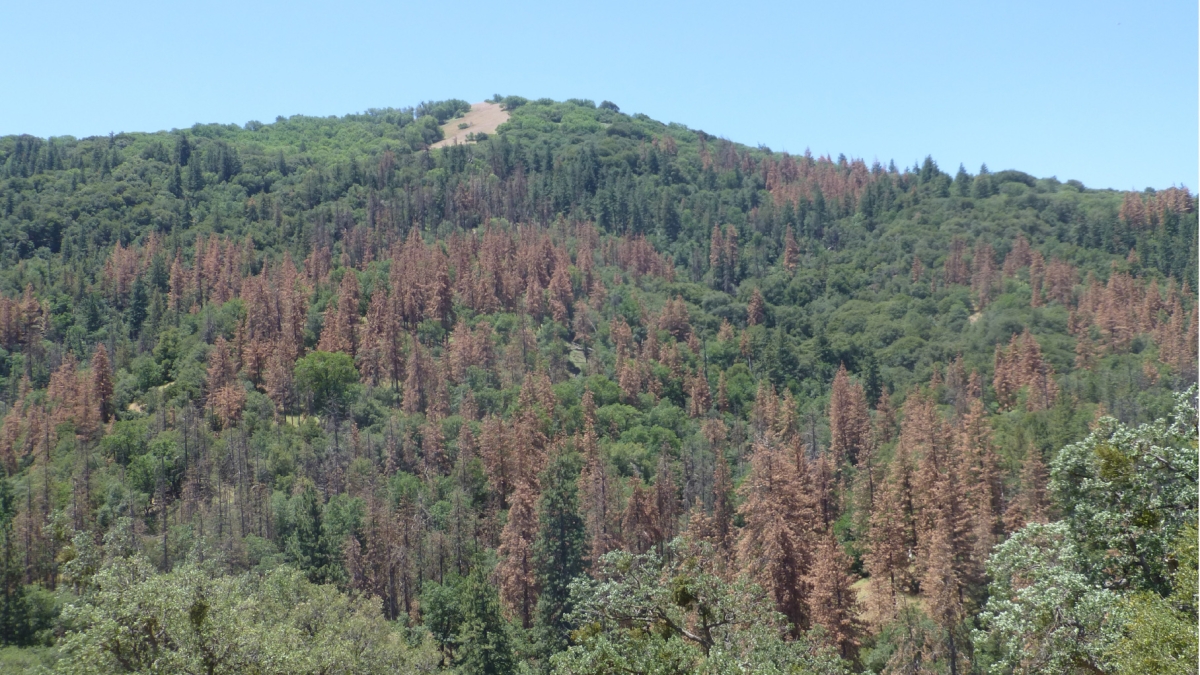How will global change impact terrestrial plant communities?

In the Tehachapi Mountains in southern California, the brown-needled conical crowns on the midslope are Pinus ponderosa that are dying as a result of the most severe drought ever recorded in California. (Photo by Ian McCullough, Tejon Ranch Conservancy, 9 Jun 2014)
Terrestrial plant communities include forests, woodlands, shrublands and grasslands. The health of all these vegetation communities is critical to humans — not just because of how we draw on them directly for food, feed for animals and other resources, but because plant communities pay a key role in processing carbon, oxygen, water and nitrogen, and thus impact the earth’s oceans, atmosphere and climate.
In a newly-published paper, Janet Franklin, Regents' Professor in Arizona State University's School of Geographical Sciences and Urban Planning, reports on a review she and several collaborators conducted of recent research dealing with threats to terrestrial plant communities. These threats include climate change associated with rising atmospheric concentrations of greenhouse gasses, however other global factors play key roles as well — such as human-induced land-use change, altered occurrence of wildfires and other disturbances, and introduction of invasive species.
To build a thorough picture of current investigations, Franklin and her colleagues reviewed over 150 recent papers, authored by researchers around the world. Although varied in approach, much of the research reviewed made use of computer modeling to project the future effects on ecosystems of the various elements of global change.
“These forecasts are informed by a rich legacy of observational and experimental studies, including historical data spanning centuries, and paleo-environmental studies spanning millennia,” Franklin said. “They all point to highly dynamic terrestrial vegetation, responsive to climate and other global change factors.”
Based on the review, Franklin and her colleagues found several patterns were observed again and again.
“First, we found that globally, forests of drier landscapes are being stressed by drying effects of anthropogenic climate change — a warmer world is relatively drier as far as plants are concerned, and this stress can be more important than the direct effects of higher temperature,” Franklin said.
Second, this drought stress can interact with fire regimes, insect outbreaks, and other human-induced landscape changes. Vegetation responses to land use and disturbance can be more immediate than to climate change, and can be long lasting.
Because of the complexity of the way different types of stresses occur, and how plants respond to them, understanding vegetation dynamics requires understanding the interactions among the various global change factors.
“While research in this area has helped us identify several clear trends, there’s much more to be done to improve on our ability to predict vegetation response,” Franklin said.
While computer models by their nature must simplify reality, it will be helpful to develop modeling frameworks that can account for more of the complexity of what happens in the real world. There’s also a great need for more detailed location information about plants, to provide a spatially explicit picture against which change can be assessed.
Franklin’s review was published in the Proceedings of the National Academy of Sciences (PNAS) in a paper entitled “Global change and terrestrial plant community dynamics.” As a newly-elected Fellow of the National Academy of Sciences, Franklin was invited to write an inaugural paper for the group’s flagship journal.
“It was a great challenge and opportunity, to summarize the state of the art in studies of global vegetation change,” she said.
Franklin co-authored the study with three close collaborators, Josep M. Serra-Diaz of ASU and Harvard University, Alexandra D. Syphard of the Conservation Biology Institute, and Helen M. Reagan of the University of California, Riverside.
The School of Geographical Sciences and Urban Planning is part of the College of Liberal Arts and Sciences.
More Science and technology

ASU postdoctoral researcher leads initiative to support graduate student mental health
Olivia Davis had firsthand experience with anxiety and OCD before she entered grad school. Then, during the pandemic and as a…

ASU graduate student researching interplay between family dynamics, ADHD
The symptoms of attention deficit hyperactivity disorder (ADHD) — which include daydreaming, making careless mistakes or taking…

Will this antibiotic work? ASU scientists develop rapid bacterial tests
Bacteria multiply at an astonishing rate, sometimes doubling in number in under four minutes. Imagine a doctor faced with a…